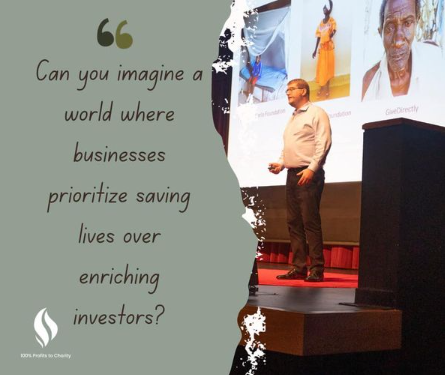Do not read further if you do not like feeling uncomfortable or being challenged. But I hope you will read further, think about this carefully, feel the intense sadness, and join in our collective discomfort. Why? Because although we can’t make that discomfort go away, we can use it to motivate ourselves to donate more effectively as well as more generously than we normally do, and save more lives.
As you know, famine is currently threatening 20 million lives over four East African countries. As you also know, extreme poverty causes preventable disease and death for millions around the world each year. You could justify not helping if you don’t feel the same responsibility to save the lives of many children who live in Africa as you would to save a single child drowning in a pond right in front of you. You can deny the “inconvenient truth” that you can use your resources to save lives. But the question we hope you will ask is not whether to help, but how best to help? Unfortunately, there is no clear answer. What is clear is that if we do not donate, many more children–and adults–will die needlessly. So let’s look at the facts and make decisions that speak to both our heads and our hearts.
Two and one-half million children under five die from preventable deaths every year. These are deaths that many of The Life You Can Save’s recommended nonprofits’ work of proven effectiveness are able to prevent (all support escaping poverty, which in turn can protect against vulnerability to disasters such as famine ). On top of that “business as usual” level of deprivation, the current famine in Yemen, Somalia, Nigeria, and South Sudan, described by Stephen O’Brien, the U.N.’s humanitarian chief, as “…the largest humanitarian crisis since the creation of the United Nations”, threatens the lives of another 1.4 million children and twenty million people in total in the coming months.
The Life You Can Save’s usual advice regarding donating for crisis relief is similar to that of the outstanding nonprofit evaluator, GiveWell, explained here. The bottom line is that it is often best to donate regularly to nonprofits with proven effectiveness at saving lives and reducing unnecessary suffering. But as O’Brien points out, with twenty million lives at stake, the current famine is no “normal” crisis, so on the one hand, it seems both emotionally and logically exigent to contribute to a nonprofit that is providing famine assistance.
Unfortunately, there are many factors (as always!) that complicate such giving. As Columnist Nicholas Kristof points out, this famine is to a large extent man-made–not least of all by actions of the U.S.–and it seems reasonable to assume that some of the political factors that caused it may well hinder famine relief efforts. Further complicating a decision of where to donate is that we do not know of evidence of proven track records for famine-relief agencies, like those mentioned in this Guardian article. On the other hand, the nonprofits on The Life You Can Save’s and GiveWell’s lists are recommended because of their years of evidence-backed work reducing preventable deaths in sub-Saharan Africa every day.
Here are three suggested ways to respond:
- Give via Oxfam’s East Africa famine relief page
- Give to one of the nonprofits mentioned in the Guardian article doing famine relief work in the four East African countries
- Give to one or more of The Life You Can Save’s recommended nonprofits–many do proven life saving work and all support reducing extreme poverty and its attendant vulnerabilities
Good luck in your decision making. The only bad choice is not adding to your normal giving pattern.
Good living and Good Giving!



